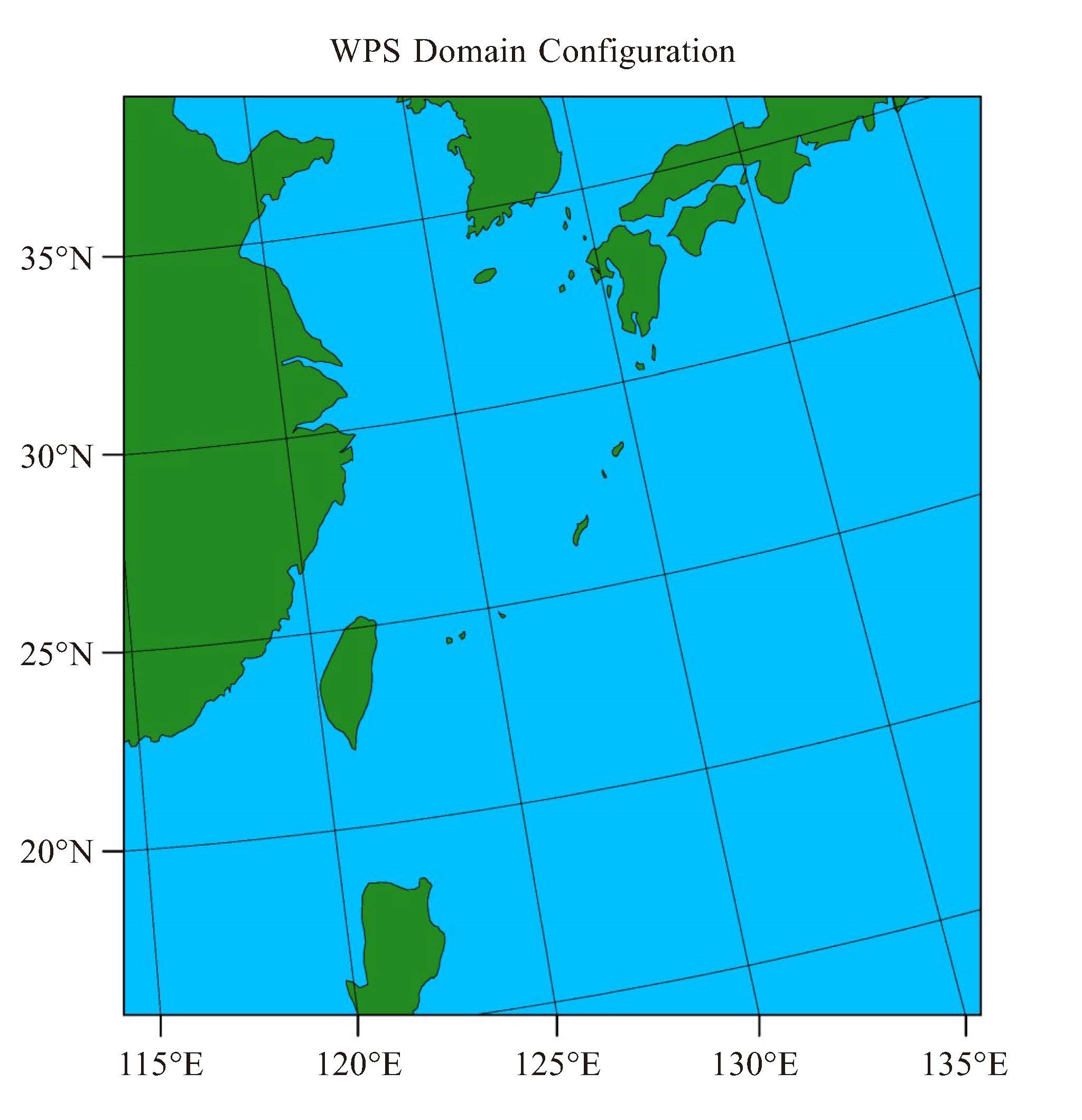INFLUENCE OF DIFFERENT MICROPHYSICAL SCHEMES ON SIMULATION OF TYPHOON LEKIMA'S RAINBAND
-
摘要: 云微物理过程是影响台风降水数值模拟的关键过程。利用华东中尺度模式系统,选取Thompson与CLR两种微物理参数化方案对台风“利奇马”进行数值模拟,对比观测、卫星资料,评估两个微物理参数化方案对台风模拟的影响,结果表明:相比于Thompson方案,CLR方案对台风“利奇马”的模拟在登陆后的路径、强度、降水明显更接近观测;Thompson方案在距离台风中心约100 km形成较强的螺旋雨带,而CLR方案在距离台风中心150 km左右的位置形成了较弱的螺旋雨带。进一步的分析表明,CLR方案模拟出的外围雨带距离台风中心的距离更远,是由于CLR方案中冰、霰等冰相态水凝物下落速度更小,更有可能被推送到距离台风中心更远的位置,从而形成不同的雨带分布。Abstract: Cloud microphysical process is a key process that may affect the numerical simulation of typhoon precipitation. In this paper, simulations of Typhoon Lekima are carried out by using the Shanghai Meteorological Service WRF ADAS Real-Time Modeling System with two different microphysical parameterization schemes, i.e., Thompson and CLR. Observational data and satellite data are compared to evaluate the impact of the two schemes on typhoon simulation. The results show that the simulation using the CLR scheme is significantly closer to observations compared with that using the Thompson scheme, especially after landing. The model using Thompson scheme shows strong spiral rainbands distribution about 100km away from the typhoon center, while the model with CLR scheme presents weaker rainbands at the distance of about 150km from the typhoon center. Further analysis indicates that the outer rainbands simulated using the CLR scheme are further away from the typhoon center due to lower falling speed and longer diameter of ice-phase hydrometeors in the CLR scheme; ice-phase hydrometeors are more likely to be pushed to places further away from typhoon center, leading to different rainbands.
-
Key words:
- microphysics /
- numerical simulation /
- Typhoon Lekima /
- rainband
-
表 1 微物理方案的水凝物预报变量
方案名称 质量浓度比 数浓度比 Thompson qc、qr、qi、qs、qg nc、nr、ni CLR qc、qr、qi、qs、qg nc、nr、ni、ns、ng -
[1] 陈联寿, 罗哲贤, 李英. 登陆热带气旋研究的进展[J]. 气象学报, 2004, 62(5): 541-549. [2] 董美莹, 陈联寿, 郑沛群. 登陆热带气旋暴雨突然增幅和特大暴雨之研究进展[J]. 热带气象学报, 2009, 25(4): 495-502. [3] 张大林. 各种非绝热物理过程在中尺度模式中的作用[J]. 大气科学, 1998, 22(4): 548-561. [4] 史月琴, 楼小凤. 显式云物理方案的研究进展[J]. 气象科技, 2006(5): 513-520. [5] ROGERS R F, BLACK M L, CHEN S S, et al. An evaluation of microphysics fields from mesoscale model simulations of tropical cyclones. Part Ⅰ: Comparisons with observations[J]. J Atmos Sci, 2007, 64(6): 1811-1834. [6] FRANKLIN C N, HOLLAND G J, MAY P T. Sensitivity of tropical cyclone rainbands to ice-phase microphysics[J]. Mon Wea Rev, 2005, 133(8): 2473-2493. [7] TAO W K, SHI J J, CHEN S S, et al. The impact of microphysical schemes on hurricane intensity and track[J]. Asia-Pacific J Atmos Sci, 2011, 47(1): 1-16. [8] WANG Y. An explicit simulation of tropical cyclones with a triply nested movable mesh primitive equation model: TCM3. Part Ⅰ: Model description and control experiment[J]. Mon Wea Rev, 2001, 129 (6): 1370-1394. [9] WILLOUGHBY H E, JIN H L, LORD S J, et al. Hurricane structure and evolution as simulated by an axisymmetric, nonhydrostatic numerical model[J]. J Atmos Sci, 1984, 41(7): 1169-1186. [10] YANG M J, CHING L. A modeling study of Typhoon Toraji (2001): physical parameterization sensitivity and topographic effect[J]. Terrestrial, Atmospheric and Oceanic Sciences, 2005, 16 (1): 177-213. [11] WANG Y. How do outer spiral rainbands affect tropical cyclone structure and intensity[J]. J Atmos Sci, 2009, 66(5): 1250-1273. [12] WANG Y. Recent research progress on tropical cyclone structure and intensity[J]. Tropical Cyclone Research and Review, 2012, 1(2): 254-275. [13] CHAN K T F, CHAN J C L. Sensitivity of the simulation of tropical cyclone size to microphysics schemes[J]. Adv Atmos Sci, 2016, 33(9): 1024-1035. [14] LI Z, ZHANG Y T, LIU Q J, et al. A study of the influence of microphysical processes on Typhoon Nida (2016) using a new double-moment microphysics scheme in the Weather Research and Forecasting model[J]. J Trop Meteor, 2018, 24(2): 123-130. [15] 周炳君, 李昕, 陈耀登, 等. GPS ZTD资料同化对台风"利奇马"模拟的研究影响[J]. 气象科学, 2020, 40(1): 11-21. [16] SKAMAROCK W C, KLEMP J B, DUDHIA J, et al. A description of the advanced research WRF version 3[M]. 2008. [17] IACONO M J, DELAMERE J S, MLAWER E J, et al. Radiative forcing by long-lived greenhouse gases: Calculations with the AER radiative transfer models[J]. J Geophys Res Atmos, 2008, 113: D13103. [18] DUDHIA J. Numerical study of convection observed during the winter monsoon experiment using a mesoscale two-dimensional model[J]. J Atmos Sci, 1989, 46(20): 3077-3107. [19] HONG S Y, NOH Y, DUDHIA J. A new vertical diffusion package with an explicit treatment of entrainment processes[J]. Mon Wea Rev, 2006, 134(9): 2318-2341. [20] NIU G Y, YANG Z L, MITCHELL K E, et al. The community Noah land surface model with multiparameterization options (Noah-MP): 1. Model description and evaluation with local-scale measurements[J]. J Geophys Res Atmos, 2011, 116(D12). [21] MEBUST M R, EDER B K, BINKOWSKI F S, et al. Models-3 Community Multiscale Air Quality (CMAQ) model aerosol component 2. Model evaluation[J]. J Geophys Res Atmos, 2003, 108(D6). [22] REISNER J, RASMUSSEN R M, BRUINTJES R T. Explicit forecasting of supercooled liquid water in winter storms using the MM5 mesoscale model[J]. Quart J R Meteor Soc, 1998, 124(548): 1071-1107. [23] CHEN J P, LIU S. Physically based two‐moment bulkwater parametrization for warm‐cloud microphysics[J]. Quart J R Meteor Soc, 2004, 130(596): 51-78. [24] THOMPSON G, RASMUSSEN R M, MANNING K. Explicit forecasts of winter precipitation using an improved bulk microphysics scheme. Part Ⅰ: Description and sensitivity analysis[J]. Mon Wea Rev, 2004, 132 (2): 519-542. [25] THOMPSON G, FIELD P R, RASMUSSEN R M, et al. Explicit forecasts of winter precipitation using an improved bulk microphysics scheme. part ii: implementation of a new snow parameterization[J]. Mon Wea Rev, 2008, 136(12): 5095-5115. [26] 李麒崙, 张万昌. GPM与TRMM降水数据在中国大陆的精度评估与对比[J]. 水科学进展, 2017, 29(3): 303-313. [27] 杨文霞, 冉令坤, 洪延超. 台风Wipha云微物理特征数值模拟[J]. 科技导报, 2010, 28(23): 34-39. [28] 邓琳. 台风的云微物理特征及其演变机制研究[D]. 北京: 中国气象科学研究院, 2020. -






 下载:
下载:











 粤公网安备 4401069904700003号
粤公网安备 4401069904700003号